A growing number of countries think they have unmasked the man running the Islamic State terror group’s global operations.
A report issued this week by the United Nations Sanctions Monitoring Team, based on U.N. member state intelligence, said there is “growing confidence” that the IS caliph is Abdul Qadir Mumin, who also heads the terror group’s branch in Somalia.
The importance of Mumin to IS’s global operations has not been in doubt. Previous U.N. intelligence reports suggested he had been elevated to lead the Islamic State’s general directorate of provinces, essentially giving him control over the group’s African affiliates.
That assessment seems to be gaining traction, with many U.N. member states agreeing that IS is trying to adapt to realities on the ground in Iraq and Syria that make moving key officials and functions elsewhere advantageous.
“It may signify a deliberate pivot toward a more decentralized operational structure, further from the core conflict zone,” the report said.
Not all countries that contributed intelligence for the report are in agreement.
Some remain unconvinced that the terror group, also known as ISIS or Daesh, would readily forsake its core territory in Iraq and Syria. Others question whether IS would allow itself to be led by someone who cannot credibly claim to be descended from the Prophet Muhammad, a criterion applied to past leaders.
Survival, however, may be more important.
Since the deaths of IS leader Abu Bakr al-Baghdadi in 2019 and his successor in 2022, the terror group has sought to protect its leaders by hiding their identity and by minimizing public appearances.
The group has publicly referred to its current leader only by his nom de guerre, as Abu Hafs al-Hashimi al-Qurashi, which signifies he has the required lineage.
“Maybe they have now got so used to the fact that the emir, or the caliph, is never seen or heard,” said Edmund Fitton-Brown, a former U.N. counterterrorism official who is a senior adviser for the Counter Extremism Project.
“Maybe they say Abu Hafs al-Hashimi al-Qurashi is the name we are giving to the caliph,” Fitton-Brown told VOA. “Nobody will ever know that he’s Somali. Nobody will ever hear an African accent. Nobody will ever see an African person.”
Already, Abu Hafs has outlasted his direct predecessor, who died after ruling for about six months.
And if Abu Hafs is Somalia’s Mumin, he also has managed to survive at least one attempt on his life — a U.S. airstrike in May 2024.
This week’s report from the U.N. said that since that strike, Mumin has “taken measures to limit the group’s exposure to unnecessary external attention.”
It also described Mumin’s base of operations, Buur Dhexaad, as a series of caves and defensive structures in the Cal Miskaad range of Somalia’s Golis Mountains, which are thought to provide protection from Western airstrikes.
That assumption is being put to the test as Buur Dhexaad appears to be the same area targeted by a new round of U.S. airstrikes earlier this month.
U.S. officials said those strikes successfully killed Ahmed Maeleninine, a key external operations leader, and 13 IS operatives.
The U.N. report warned that IS-Somalia, under Mumin’s leadership, has continued to gain influence while strengthening its finances.
Intelligence shared from member states indicated IS-Somalia expanded its extortion activities in parts of Somalia under its control and has, in turn, invested the money in improving its military capabilities, including unmanned drones for surveillance and suicide attacks.
But the affiliate, which saw its forces surge thanks to an influx of foreign fighters, has seen its growth slow of late.
The report said IS-Somalia saw a spike in defections due to “difficulties in integrating fighters into narrow clan-based structures, cultural barriers and the severity of conditions.”
Efforts to intercept would-be foreign fighters before they can reach Somalia also have taken a toll.
Syria and Iraq
Key members of IS’s leadership may be seeking refuge in Somalia, but there are no indications the terror group has given up its designs on retaking territory in Syria and Iraq.
The U.N. report said the terror group still maintains about 1,500 to 3,000 fighters across the two countries, with most operating out of Syria.
There are also indications that IS has found ways to take advantage of the fall of Syrian President Bashar al-Assad this past December.
Some U.N. member states’ intelligence agencies said some IS operatives leaped into action even as the lead Syrian insurgent group, Hayat Tahrir al-Sham (HTS), launched its assault on the Assad regime.
One IS operative, they said, infiltrated the al-Hol displaced-persons camp in northeastern Syria and sneaked out experienced IS fighters by replacing them with teenage boys.
The same operative is thought to have reactivated an IS brigade at al-Hol “tasked with intelligence-gathering, training young people for operations, recruiting and managing funds.”
Additionally, the report warned of IS launching increasingly sophisticated attacks against the U.S.-backed Syrian Democratic Forces.
IS in Iraq has been weakened by Iraqi counterterrorism pressure, including an operation in August that killed the group’s deputy wali (governor) and 13 other leaders. But the U.N. report said IS “maintained the ability to operate and replace field commanders.”
Afghanistan presence
U.N. member states continue to raise concerns about the IS affiliate in Afghanistan, known as IS-Khorasan or ISIS-K.
The report called IS-Khorasan “the most serious threat” to Afghanistan, noting the group’s ability to infiltrate the country’s Taliban rulers and exploit dissatisfaction, especially among poppy farmers and ethnic Tajiks, with the Taliban’s rule.
U.N. member states assessed IS has about 4,000 to 6,000 operatives across Afghanistan, and that it is also building capabilities while seeking to bring in more fighters from Central Asia.
To make the journey easier, IS-Khorasan set up smuggling routes into Afghanistan through Turkey and through Iran, according to the report.
The report noted the ability of IS-Khorasan to reach into Europe and recruit minors.
“The increasing frequency of foiled plots underscored the group’s determination and capacity to conduct attacks of high lethality on European soil, primarily against soft targets and large crowds,” it said.







